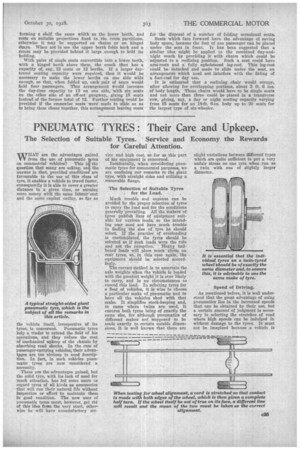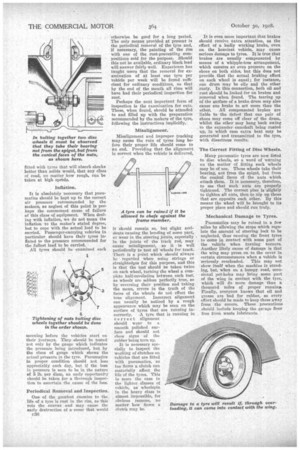• PNEUMATIC TYRES: Their Care and Upkeep.
Page 43

Page 44

If you've noticed an error in this article please click here to report it so we can fix it.
The Selection of Suitable Tyres. Service and Economy the Rewards for Careful Attention.
WAT are the advantages gained from the use of pneumatic res on commercial vehicles? This i the' question that many are asking, an4 the answer is that, provided conditions are favourable to the use of this class of tyre, it enables a vehicle to travel faster, consequently it is able to cover a greater distance in a given time, so earning more money with the same labour cost and the same capital outlay, so far as.•
the vehicle itself, irrespective of its tyres, is concerned. Pneumatic tyres help a trader to extend the field of his operations, and they reduce the cost of mechanical upkeep of the chassis by absorbing road shocks. In the case of passenger-carrying vehicles, their Oventpzes are too obvious to need description. In fact, in such vehicles pneumatic tyres are now considered a necessity.
These are the advantages gained, but the solid tyre, with its lack of need for much attention, has led some users to regard tyres of all kinds as accessories that will rim their natural life without Inspection or effort to maintain them In good condition. The new user of pneumatic tyres must, however, get rid of this idea from the very start, otherwise he will have unsatisfactory ser
vice and high cost, so far as this part of his equipment is concerned.
Incidentally, when considering pneumatic tyres for commercial purposes, we are confining our remarks to the giant type, with straight sides and utilizing a removable flange.
The Selection of Suitable Tyres for the Load.
Much trouble and expense can be avoided by the proper selection of tyres to carry the load and for the conditions generally prevailing. All the 'Makers of tyres' publish liste of equipment suitable for -varlets loads, so the intending user need mat have . much trouble in finding the size of -tyre he should select. If the practice of overloading is contemplated, the tyres should be selected as if witch loads Were the rule and not the etception. Heavy tailboard" leads will place much' stress on rear t3'res,. so, in this case again, the equipment should be selected accord ingly. '
The correct niethod is to ascertain the axle weights When the vehicle is loaded with the greatest weight it is ever likely to carry, and in no circumstances to exceed this lead. In selecting ,tyres for a fleet of vehicles, it is-Wise to choose a particular make of pneumatic and to have all the vehicles shod with that make. It simplifies stock-keeping and, in cases where twins are used, it ensures both tyres being of exactly the same size, for although pneumatics of different makes ard, rsupposed to be made exactly to. certain outside dimensions, it is well known that there are slight variations between different types which are quite sufficient to put a very unfair stress on one tyre when run as a twin with one of slightly larger diameter.
As mentioned before, it is well understood that the great advantage of using pneumatics lies in the increased speeds that can be obtained by their use, but a certain amount of judgment is necessary in selecting the stretches of road where high speeds can be indulged in without damage to the tyres. It must not be imagined because a vehicle is fitted with tyres that will absorb shocks better than solids would, that any class of road, no matter how rough, can be taken at high spieds.
It is absolutely necessary that pneumatics should be kept up to the correct air pressure recommended by the makers, as neglect of this point is perhaps the commonest cause of failure of this class of equipment. When dealing with inflation, we do not mean the inflation to the maker's stated degree, but to cope with the actual load to be carried. Passenger-carrying vehicles in particular should have their tyres inflated to the pressure recommended for the fullest load to be carried.
All tyres should be examined each
morning before the vehicles start on their journeys. They should be tested not only by the gauge which indicates the pressure being introduced, but by the class of gauge which shows the actual pressure in the tyre. Pneumatics in proper condition should not lose appreciably each day, but if the loss. in pressure is seen to be in the nature of 5 lb. per diem, an early opportunity should be taken for a thorough inspection to ascertain the cause of the loss.
Periodical Removal and Inspection.
One of the greatest enemies to the life of a tyre is rust in the rim, as this rots the canvas and may cause the early destruction of a cover that would
c36 otherwise be good for a long period. The only means provided at present is the periodical removal of the tyre and, if necessary, the painting of the rim with one of the rust-preventing comPositions sold for the purpose. Should this not be available, ordinary black lead will answer fairly well. Experience has taught users that the removal for examination of at least one tyre per vehicle per week will be found sufficient for ordinary conditions, so that by the end of the month all rims will have had their periodical inspection for rust.
Perhaps the next important form of inspection is the examination for cuts. These, when found, should be attended to and filled up with the preparation recommended by the makers of the tyre, following the instructions implicitly.
Misalignment and improper tracking may cause the ruin of tyres long before their proper life should come to an end. Providing that the alignment is correct when the vehicle is delivered, it should remain so, but slight accidents causing the bending of some part, or wear in the steering joints, especially in the joints of the track rod, may cause misalignment, so it is well periodically to test all wheels for track. There is a point which should always be regarded when using strings or straightedges for this purpose, and this is that the test should be taken twice on each wheel, turning the wheel a complete half-revolution between each test, as wheels are seldom perfectly true, so by reversing their position and taking the mean, errors in the truth of the faces of the wheels do not effect the true alignment. Incorrect alignment can usually be noticed by a rough appearance which may be seen on the surface of tyres that are running incorrectly. •A tyre that is running in correct alignment should wear to a smooth polished surface and should not show signs of the rubber being torn It is necessary specially to inspect the working of clutches on vehicles that are fitted with pneumatics, as too fierce a clutch can materially affect the life of the tyres. This is more the case in the lighter classes of vehicle, as wheelspin in the heavy class is almost impossible, for obvious reasons, no matter how fierce a clutch may be. It is even more important that brakes should receive extra attention, as the effect of a badly working brake, even on the heaviest vehicle, may cause serious damage to tyres. It is true that brakes are usually compensated by means of a whipple-tree arrangement, which ensures an even pressure on the shoes on both sides, but this does not provide that the -actual braking effect on each wheel is equal; for instance, one drum may be oily and the other rusty. In this connection, both oil and rust should be looked for on brakes and removed when found. The tearing up of the surface of a brake drum may also cause one brake to act more than the other. All compensated brakes are liable to the defect that one pair of shoes may come off clear of the drum, whilst the other may hang back owing to the expander camshaft being rusted up, in which case extra heat may be generated and transmitted to the tyre, with disastrous results.
The Correct Fitting of Disc Wheels.
Many pneumatic tyres are now fitted to disc wheels, so a word of warning on the matter of fitting such wheels may be of use. These wheels take their bearing, not from the spigot, but from the conical faces of the nuts which attach them. It is necessary, therefore, to see that such nuts are properly tightened. The correct plan is slightly to tighten all nuts, then to nip up those that are opposite each other. By this means the wheel will be brought to its proper place and should run truly.
Mechanical Damage to Tyres.
Pneumatics may be ruined in a few miles by allowing the stops which regulate the amount of steering lock to be neglected, thus causing the front tyres to come in contact with some part of the vehicle when turning 'corners. Another likely cause of damage is that the wing may press on to the cover in certain circumstances when a vehicle is seriously overloaded. This may not sbow itself when the machine is standing, but, when on a bumpy. road, occasional pot-holes may bring some part of the wing in contact with the tyre, which will do more damage than a thousand miles of proper running.. Finally, everyone knows that oil and grease are bad for rubber, so every effort should be made to keep these away from the covers. These precautions should include keeping the garage floor free from waste lubricants.


















































